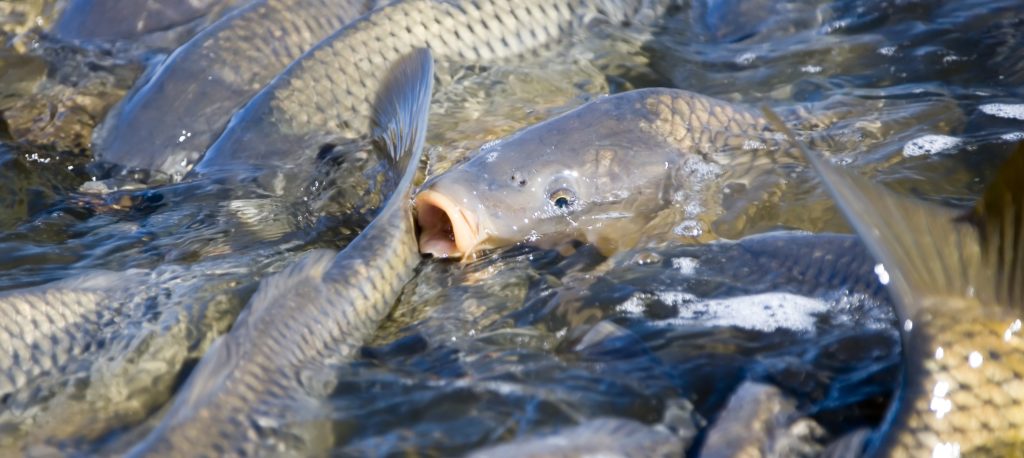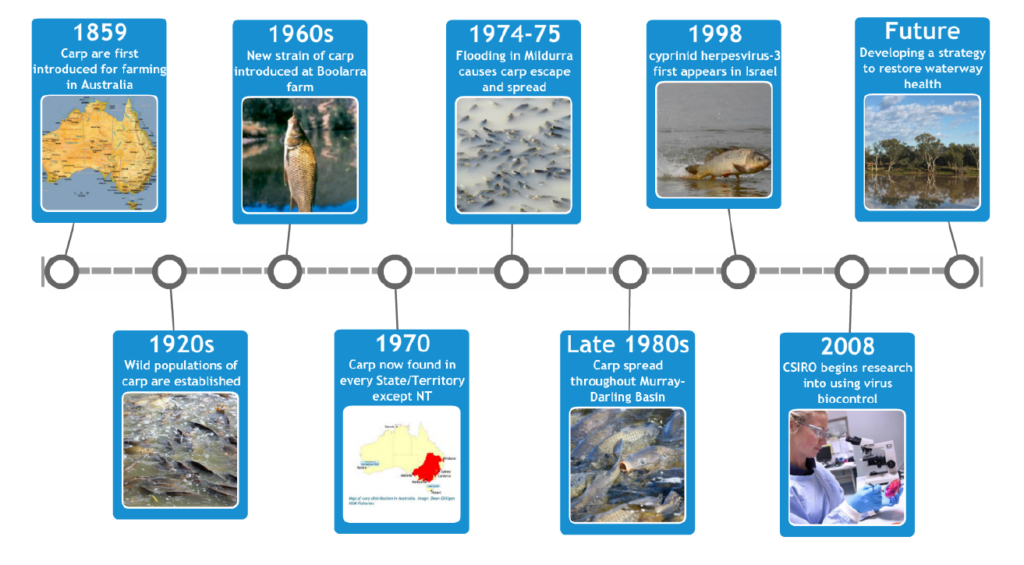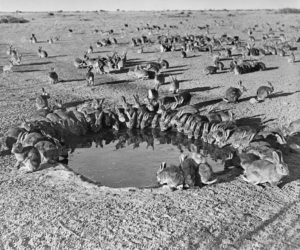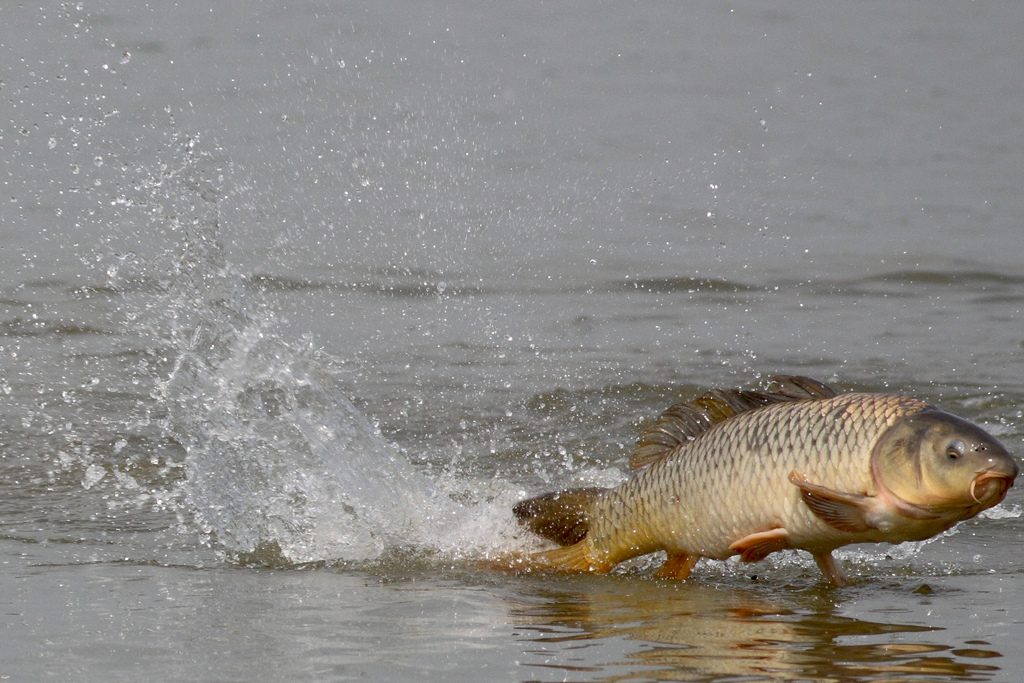A herpes virus that has been killing carp overseas could do a similar job in our waterways.

Carp-free ecosystems will be a breath of fresh air. Image: Benjamin F. Haith/Shutterstock.com
Update May 2016
On the 1st May 2016 the Australian Government announced $15 million in funding over two and a half years to develop the National Carp Control Plan to undertake further research, approvals, and consultation to develop a comprehensive plan for a potential release of Cyprinid herpesvirus (carp herpesvirus) by the end of 2018. A National Coordinator will work with stakeholders from across governments, industry, community and environmental groups, and research organisations to understand the issues and bring together a comprehensive plan, underpinned by research, risk assessment and a sound understanding of community views. The plan will focus on maximising the reduction of carp populations while minimising disruption to industries, communities and the environment should a carp herpesvirus release go ahead.
For further information visit http://www.agriculture.gov.au/pests-diseases-weeds/pest-animals-and-weeds/national-carp-control-plan
Carp herpes virus
A European Carp. Image: Dirk-Jan Kraan/Flickr
They breed like rabbits and put increasing pressure on our waterways and native wildlife. Yep, we’re talking about carp.
Just like rabbits these pesky fish multiply rapidly, reaching huge numbers quickly and are one of the most invasive and damaging pests of our freshwater ecosystems. Biocontrol agents have been successfully used to control rabbits in Australia, and we’re confident that a virus that has been killing carp overseas could do a similar job here.
This virus, once known as koi herpesvirus, is now formally known as Cyprinid herpesvirus 3 (CyHV-3). Seven years of CSIRO research, supported by the Invasive Animals-Cooperative Research Centre (CRC), has shown that the use of CyHV-3 as a biocontrol agent could significantly reduce the number of common carp (Cyprinus carpio) in our rivers.
Naturally with any talk of a biocontrol agent, there is public debate and speculation. So we thought we’d go fishing for answers to the most common questions.
1. Is it really necessary to control carp in Australia?
First introduced in Australia in 1859, carp became a major pest in the 1960s after the accidental release of a strain that had been adapted for fish farming. Within a few years they established themselves throughout the entire Murray-Darling Basin.
Carp now comprise up to 90% of the fish biomass in parts of the Basin. This is largely attributed to female carp producing up to a million eggs per year, and to the omnivorous fish’s tolerance for a wide range of habitats including degraded water. While we may not be able to ‘prove’ that carp directly caused the degradation of our rivers, their dominance must certainly contribute to the problem. It is unlikely that the Murray-Darling Basin could ever return to its previous glory while carp remain in such high numbers.
Our views in Australia are supported by research from the US. This showed that carp muddy their waters resulting in flow-on effects on plants, invertebrates, bird-life and native fish in shallow lakes. Researchers concluded that common carp damage the ecology of shallow lakes, particularly when carp density reaches levels similar to those in parts of the Murray-Darling Basin.

2. Will CyHV-3 be effective as a biocontrol agent?
CyHV-3 first appeared in Israel in 1998 and quickly spread throughout the world, killing-off common and koi carp. Ironically carp are farmed in many countries and are an important food source. So, while CyHV-3 has devastated carp farming, the overseas experience has demonstrated how it could be used successfully as a biocontrol agent here.
Testing of CyHV-3 in the high-security Fish Diseases Laboratory at our Australian Animal Health Laboratory (AAHL), in Geelong, Victoria, has proven that the same virus does in fact kill Australian carp, and it kills them fast.
The flip side is our rigorous testing to ensure that the virus won’t affect native Australian or important introduced species of fish. It has been shown to pose no danger to 13 native species such as Murray cod, various species of perch, eel and catfish, as well as a crustacean (yabbies) and a non-native fish species, the rainbow trout. Our work has shown that there are no clinical or pathological changes in these non-target animals, nor is there any evidence that the virus multiplies in these species.
Chickens, mice, frogs, turtles and water dragons have also been tested as representatives of a wider community of birds, mammals, amphibians and reptiles. Again the virus has shown no effect on them which also makes us confident that it won’t affect that other major group of mammals – humans.
Based on lessons learnt from past use of viral biocontrol agents for invasive vertebrates, we expect that CyHV-3 will have the greatest impact in the first couple of years after release. After that, its effectiveness may be diminished, but not lost, as virus and host adapt to each other.
Therefore, we need an integrated pest management program that utilizes other methods to complement our virus. These include new broad-scale technologies such as ‘daughterless’ technology to create male-only populations, as well as traditional regional methods such as trapping, the commercial collection of carp, and controlling access of carp to breeding grounds.
3. What happens to the dead carp?
Juvenile carp aggregated below the Menindee Main Weir on the Darling River. Image: Nigel Harriss, NSW Office of Water.
If an image of rivers full of large dead carp floating on the surface is what springs to mind, rest assured that our research includes careful planning and modelling before release and follow-up strategies are recommended.
Carp breed in well-mapped specific sites along the Murray-Darling Basin. The virus is likely to be released in these sites where most carp are juveniles. Not only would this wipe out large populations of carp before they become mature, but bird life will probably clean up large numbers of the immature carp.
Study tours of Japan and Indonesia are part of the Invasive Animals-CRC program to study natural outbreaks of CyHV-3. Researchers will be reviewing the significance of dead mature fish, and strategies for dealing with them.
4. How can we be sure that widespread distribution of the virus is safe for people?
CyHV-3 has devastated carp farming around the world yet despite the large numbers of people working on these affected farms, there has been no evidence of any effect of the virus on them.
We have also exposed mice to CyHV-3, and found no evidence of disease. Mice were chosen as being a representative mammal, just like a human.
And finally, a report to the European Commission by the Scientific Committee on Animal Health and Animal Welfare stated that there is no evidence for ANY fish virus causing disease in humans.
So what’s the verdict?
Given our very good understanding of both the biology of CyHV-3 and of carp in Australia, we are optimistic that this carp virus will make a significant impact on carp in this country. And for that, our river systems and native fish will be very grateful.
UPDATE: A carp’s tale – you ask, we answer
18 January 2016 |by Cassandra Leigh and Emma Pyers
Your questions came in thick and quick when you heard we’re working on a biocontrol option for managing European carp numbers in Australia. We’re not fishing around – we take biocontrol research seriously. So, we sat down with our resident koi carp expert Ken McColl to answer all your burning questions.
How does the herpes virus work?
The virus – CyHV-3 – mainly damages the kidneys, skin and gills of koi carp. Kidney and skin are very important in helping the fish maintain its water balance. Animals living in a freshwater environment need to stop water getting into the body (skin) and to pump out excess water that does get in (kidneys). In affected fish there is a water imbalance which causes a mineral imbalance. Among other things, the latter could affect heart function (although that has not yet been shown in carp). Damage to the gills affects the carp’s ability to breathe and this is the cause of death.
After a fish is infected by the virus, the virus multiplies in the fish for about seven days (depending on the water temperature). During this time the fish eats and appears quite normal. It then takes about 24 hours from the first signs of disease (darkening of the skin; reddened gills) until the fish dies.
How is it transmitted?
Most commonly the virus appears to be transmitted by direct contact between fish, but fish can also be infected by virus in the water. The virus alone will never wipe out carp completely; there will always be some survivors. As in ANY herpesvirus infection in any host, survivors are infected with herpesvirus for life. These are what is known as latent infections, where the virus is present but does not seem to cause any signs of disease. However, if a latently-infected animal is stressed for any reason then the virus re-activates and can be spread. This should allow the virus to survive in the carp population.
Can the virus live outside the carp body?
The virus survives for only a few days outside a fish.
How do you know it won’t infect other species?

We have demonstrated that CyHV-3 does not pose a danger to 13 native species, including the Murray cod
We have done rigorous testing to ensure that the virus won’t affect native Australian or important introduced species of fish. It has been shown to pose no danger to 13 native species such as Murray cod, various species of perch, eel and catfish, as well as a crustacean (yabbies) and a non-native fish species, the rainbow trout. Our work has shown that there are no clinical or pathological changes in these non-target animals, nor is there any evidence that the virus multiplies in these species.
Chickens, mice, frogs, turtles and water dragons have also been tested as representatives of a wider community of birds, mammals, amphibians and reptiles. Again the virus has shown no effect on them which also makes us confident that it won’t affect that other major group of mammals – humans.
Will the infected fish be safe for animals and people to eat?
CyHV-3, which was first discovered in Israel in 1998, has devastated carp farming around the world yet despite the large numbers of people working on these affected farms, there has been no evidence of any effect of the virus on them. We have also exposed mice to CyHV-3, and found no evidence of disease. Mice were chosen as being a representative mammal, just like a human. Finally, a report to the European Commission by the Scientific Committee on Animal Health and Animal Welfare stated that there is no evidence of ANY fish virus causing disease in humans.
What’s to stop the virus mutating and infecting other species?
When it comes to understanding the effects of mutations in viruses, work on many viruses over many years has resulted in some general observations. Firstly, some viruses are naturally promiscuous, meaning they will infect a wide range of species (e.g. the influenza viruses). Herpesviruses are NOT considered to belong to this promiscuous group of viruses. In fact, herpesviruses are generally considered to be species-specific, i.e. each host species has its own herpesvirus(es). Secondly, viruses that are species-specific can occasionally jump into new hosts, but these jumps seem to be determined by two factors.
- The vast majority of virus jumps really only occur between closely-related host species (e.g. AIDS virus and Ebola virus jumping from non-human primates into humans).
- The nature of the genetic material of the virus. Viruses can be broadly classified as RNA or DNA viruses depending on the nature of their genetic material. DNA viruses (like koi herpesvirus) are relatively stable, whereas RNA viruses (like AIDS virus, Ebola virus, influenza virus) are much more likely to undergo mutations that potentially allow these viruses to jump hosts (although, as already mentioned, generally the jump is still into a closely-related species). In comparison, koi herpesvirus is a very large and complex DNA virus, and as a result they are

Rabbit numbers have been considerably reduced by the introduction of two viruses - Rabbit calicivirus and myxoma.
Rabbit numbers have been considerably reduced by the introduction of two viruses – Calicivirus and Myxoma.
rarely associated with jumps.
It’s worth noting that two viruses have been released in Australia to control rabbits, the Calicivirus (an RNA virus) and before that, the virus causing Myxomatosis (a complex DNA virus). These viruses have been present in Australia for around 20 and 60 years respectively and there is still no evidence of either virus jumping into another host during all that time.
For koi herpesvirus, the important observation is that it has only been found in carp. Carp belong to a group of fish known as cyprinids, and there are no native cyprinids in Australian waterways. The native fish in Australia that are most closely related to cyprinids are the native catfish. The susceptibility of two different species of native catfish to koi herpesvirus has been tested, and there was no evidence of disease or of virus multiplication in either species.
Won’t carp eventually develop resistance to the virus?
Whenever a virus is used as a biocontrol agent, the virus kills large numbers of the target for the first couple of years. But, gradually the virus and host come to a state of equilibrium that allows both to survive. At that point there has been a marked initial reduction in the numbers of the target, and the virus then continues to cause a lower level mortality in the target such that the target numbers never recover to their original levels.
We’ve seen this happen with both the Calicivirus and the Myxoma virus in their effects on rabbits, and those viruses still do a great job in controlling rabbit numbers in Australia.
What will happen to ornamental fish bred intentionally, are they likely to be infected eventually?
Goldfish are not affected by this virus. However, koi carp are completely susceptible, and therefore, for people trying to raise koi, normal biosecurity measures will need to be taken. This may mean treating inflowing water with chemicals, heat, or UV to kill any virus that might be present.
Also, any new fish introduced to an aquarium should be held in quarantine – about two-four weeks for koi (which could be incubating the virus) and any also for other species that may have had contact with carp/koi (they could be inadvertently carrying the virus on their gills or skin even though it will not cause disease in these species).
What about the businesses that rely on carp?
Businesses that harvest carp to use as fertilizer will still be able to do this, as the initial release will mean a lot of dead fish will be available for this purpose. Even as numbers diminish there will still be carp available as the virus alone will not eradicate all the carp, so it’s important that we have complimentary control measures, like harvesting, to keep numbers low.
So there will be a lot of dead carp floating around?
The release would be coordinated at a location and time that coincides with breeding, so it would initially kill young fish before spreading throughout the waterways. The dead fish will be an easy food source for many bird species, and in addition will still be able to be harvested for fertilizer.
When will the virus be released?
It is difficult to place a timeline on any biocontrol program. We’ll continue to undertake studies with non-target fish species to ensure the virus remains species specific and only affects carp. Following this, the Invasive Animals CRC (funding body) will work with the relevant parties to progress the biocontrol agent through the regulatory/approval processes.
For more information on biocontrol of invasive species, visit our biocontrol page.




22nd January 2018 at 5:07 pm
Has the CSIRO considered introducing the virus to a lesser river system like Brownhill Creek S A for example where results could be measured without having any massive environmental effects on the waterway. The Carp in this system are causing costly problems to wetlands in the area.
31st October 2017 at 9:21 pm
I have faith that the rigorous testing done by CSIRO means this is a safe Biocontrol agent. I hope the strategy for release can be coordinated to have maximum impact on this destructive pest.
Pingback: Australia Plans to Eliminate Invasive Carp From Murray-Darling River Basin - Circle of Blue
21st April 2017 at 10:06 am
The introduction of the Koi Herpes virus cannot come quick enough as far as I’m concerned – this country has not known anything as insidiously invasive as this animal – worse than the cane toad or the rabbit. To understand the complete and utter devastation this species has wrought on Australia’s fresh waterways you have to understand that massive numbers of carp in our large waterways are only the tip of the iceberg – they are, infact, all the way up our river systems now – into the high country.
I frequently walk into the upper reaches of rivers – like the Howqua,Jamieson, Snowy and Goulburn rivers, fly-fishing for trout – though sometimes I wonder why I bother. Even in the relatively untouched wilderness of these beautiful rivers, high in the mountains, there are now large carp inhabiting most of these rivers pools. i wade in these pools and have watched healthy ecosystems decline to the point where there is very little life left – weed, native fish, trout all gone – and with that, a substantial decline in aquatic bird life. Apart from the occasional large yabby.- just about everything’s gone – replaced with grey silt on the pool floors and a couple of large carp hoovering up anything else that’s left. You certainly dont see many fishermen anymore either – that must hurt the economies of the small mountain towns.
The nature in which they feed has decimated native fish stock and any wild trout that may have coexisted have gone as well – probably because of the drop in oxygenation and the dramatic loss of aquatic insect life..
It is worth adding that comparing salmonids (i.e., trout or salmon) to carp is wildly incorrect. Salmonids will never be a threat to native fish populations – they have a fairly tenous grip on survival in our rivers at the best of times – this country simply doesn’t have a very high volume of very cold oxygenated water which is crucial for them to thrive. Infact – if there are trout in a water way, it is usually an excellent indicator of a healthy ecosystem.
The stench of rotting carp will be short lived – and any person who’s life depends on harvesting carp can retrain themselves as a fishing guide as our native fish populations rebuild.
29th January 2017 at 3:50 pm
Why not spend that $15m with the businesses that are using carp? Pay for the carp these businesses can process? And Pay the general public to bring carp they catch to these businesses. Biochemicals will have problem for the future. You cannot put the diesease back into the bottle once released. Don’t be shortsighted, there will be karma to humans in the future. There are hungry and dying people in other parts of the world and Australia wants to waste this food? I will be happy to start a carp business to make use of this naturally abundant resource. Why not use that $15m to help people like me to start this business? My carp business will surely have positive impacts to society than just simply waste the money on killing this fish species. Why temper with natural evolution?
9th March 2017 at 10:27 am
Charlie there isn’t enough people to catch all the carp. I have just spent 45 days on the river. At one point I pulled over to the shore and there were thousands of fish sitting next to the bank eating the worms. There are already businesses that use this natural resource like Charlie carp which makes the carp into fertiliser and I believe that the government and Charlie carp are working together on how to get rid of all the floating fish.
Are you going to ship hundreds of thousands of tonnes of carp over to the countries that people are starving in?
9th March 2017 at 3:06 pm
Carp are not the primary cause of native fish decline, nor of the poor water quality…and thus their removal will not see the natives magically bounce back.
Try spending the $15 million on addressing agricultural run-off, cold-water dam pollution, dams/weirs/road crossings, removal of habitat, bank erosion from cattle and farming, wastewater etc. etc.
25th March 2017 at 5:27 pm
Matt, I would like to see the evidence for your assertion that carp are not the primary cause of fish decline. Sure, there are other detrimental impacts, such as those you list but that does not mean we should not attempt to control this feral fish as part of an overall program of improving our aquatic ecosystems.The article makes it clear that this cannot really be established one way of the other with complete confidence, but if you have a look at an infected river, you’ll agree, I’m sure, that it’s extremely hard to believe that the enormous numbers of these ominvores are NOT having a devastating impact on slower-breeding native fish, other aquatic animals and stream health in general. Perhaps the best way to answer your question is to eliminate the carp from the rivers and see what happens. What’s to be lost?? And I suspect that all of us who care about our native ecosystems be extremely pleased. Watch this space, as they say!
29th December 2017 at 5:31 pm
To all the naysayers and bleeding hearts, please go and see the damage to the native ecosystem these fish can do. I have a Billabong full of them, no native fish, no yabbies, no platypus and they eat away at the bank causing it to fall in. The water is brown and turbid as well as having a smell that is putrid to say the least. I for one would happily offer my foul smelling cesspool as a test site.